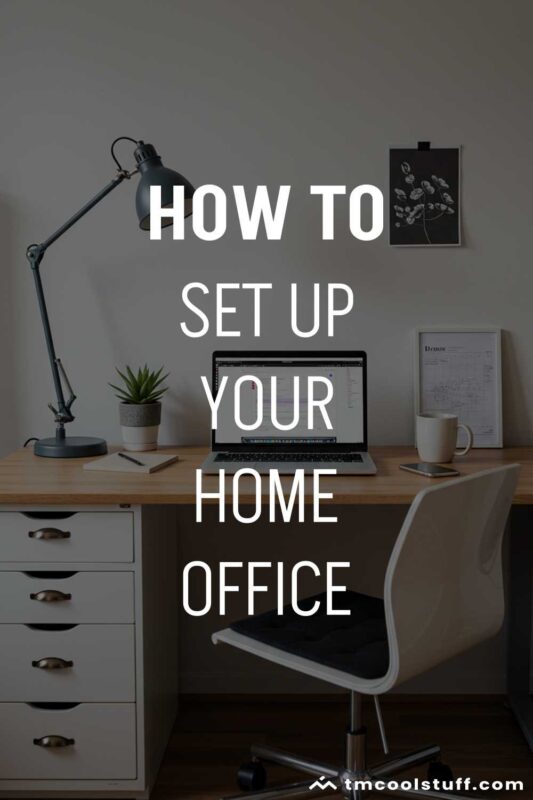Home Decor, Blog
How To Set Up a Home Office Without Spending Too Much
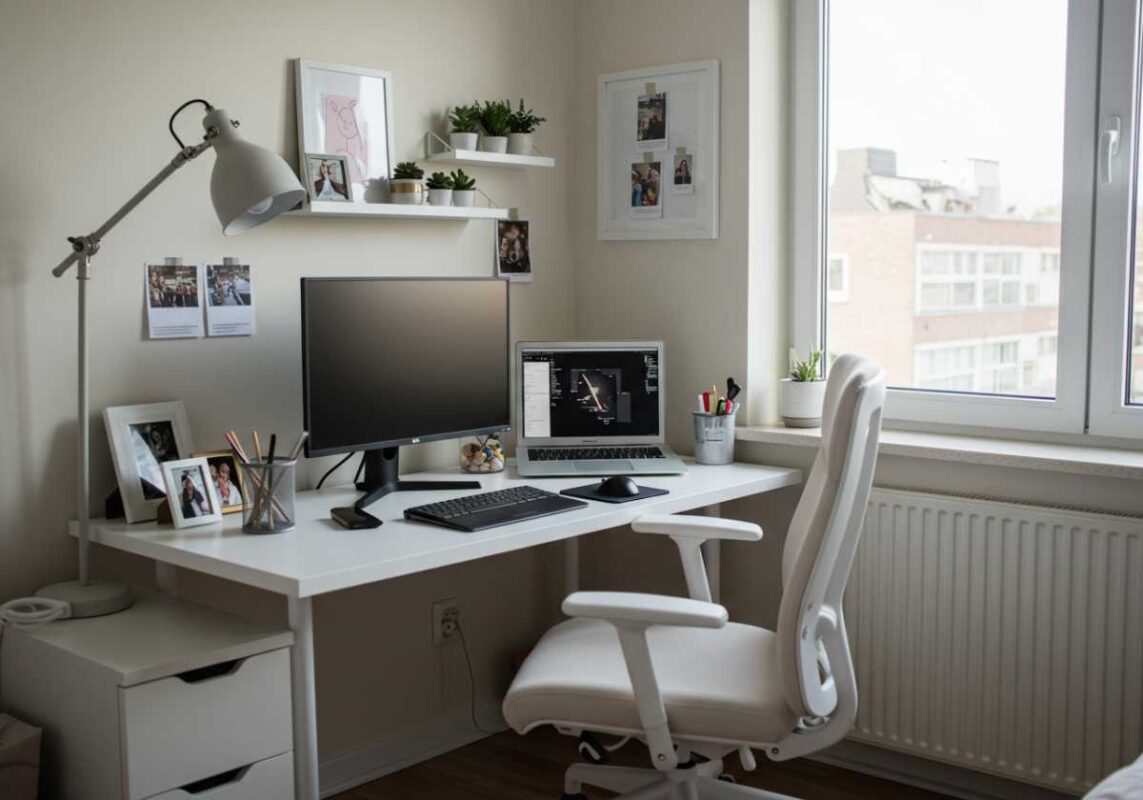
You’re trying to work from your kitchen counter, your back is screaming, and your cat keeps walking across your keyboard during important Zoom calls. Setting up a proper home office isn’t just some fancy luxury anymore; it’s basically a survival skill at this point!
I used to think I could make do with my laptop perched on a pile of books and a dining chair that was clearly designed for eating, not eight-hour work marathons. Spoiler alert: I was wrong. Dead wrong. After months of neck pain and productivity levels that could charitably be described as “tragic,” I finally decided to get my act together and create a workspace that wouldn’t make me want to quit my job and become a professional Netflix watcher.
Here’s the thing – you don’t need to spend your entire paycheck to create a home office that actually functions. I’m talking budget-friendly solutions that’ll make you wonder why you suffered for so long. Ready to transform that chaotic corner into a productivity powerhouse? Here’s how!
Table of Contents
Start With The Foundation: Your Chair and Desk Setup
Get Your Sitting Situation Sorted
Listen, I cannot stress this enough – your chair is the MVP of your home office setup. I learned this the hard way after developing what I lovingly called “laptop hunch.” Not cute.
The goal here is to support the natural S-curve of your spine. If you’re sitting against your chair’s backrest and there’s a Grand Canyon-sized gap between your lower back and the chair, you need lumbar support, stat.
Don’t have the budget for a fancy ergonomic chair right now? No worries! A lumbar pillow and seat cushion can work absolute miracles. I picked up both from Amazon for under $50, and honestly? Game changer. Your back will thank you, and you’ll actually want to sit down and work instead of dreading it.
Desk Height: It’s More Important Than You Think
Here’s something that blew my mind when I first learned it: most desks are too high for most people. Standard desks are designed for people who are around 5’10”, but the average person is shorter than that. If you’re like me (5’5″ on a good day), you’ve probably been straining your wrists this whole time.
Your arms should be parallel to the floor when you’re typing – not reaching up like you’re trying to conduct an orchestra. You’ve got a few options here:
- Keyboard tray mounted under your desk
- Raise your chair and add a footrest if your feet don’t touch the floor
- Adjustable-height standing desk (the dream option!)
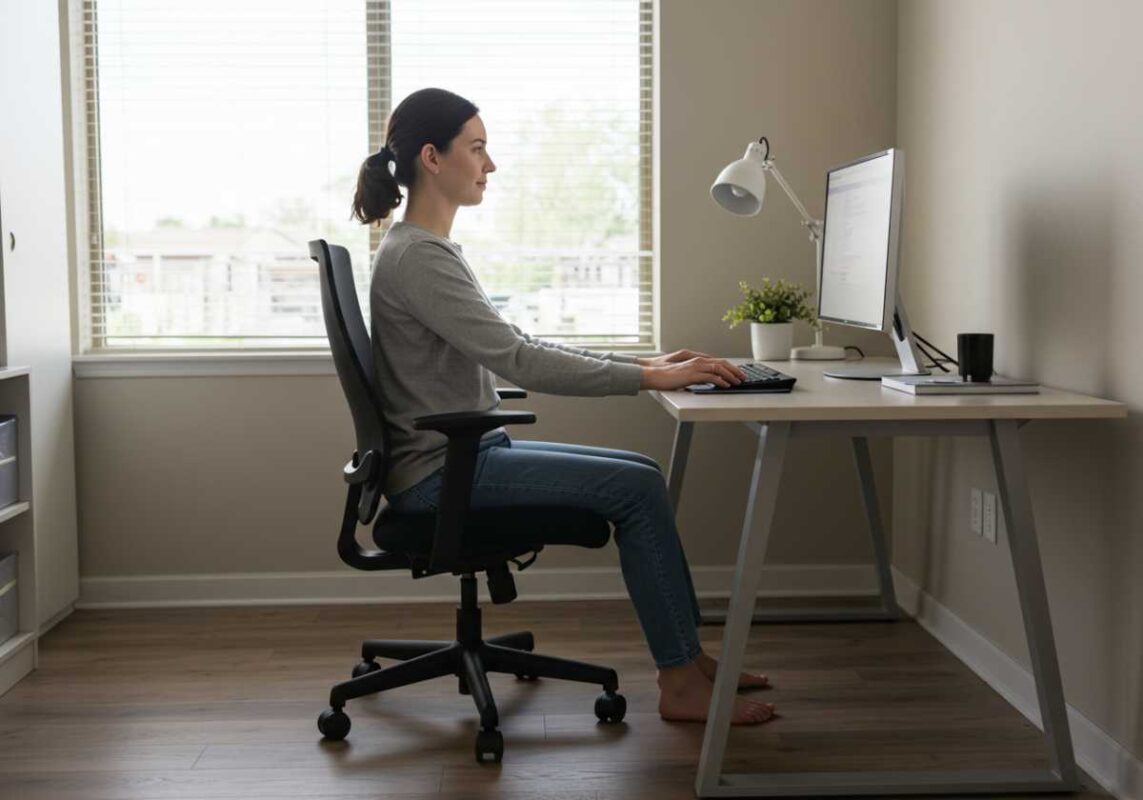
Technology That Actually Matters
Monitor Magic
Can we talk about laptop screens for a hot second? They’re fine for checking emails at Starbucks, but for full-time work? Your neck wasn’t designed to crane downward for eight hours straight.
Position your screen so your eye level hits the top of the monitor or just below it. The screen should be about arm’s length away – close enough to read comfortably, far enough that you’re not going cross-eyed.
Pro tip: You don’t need to buy a fancy monitor arm right away. I started with a stack of books under my laptop, then graduated to a simple laptop stand. The Rain Design iLevel 2 is worth every penny if you want something more stable.
Keyboard and Mouse Reality Check
If you’re still trying to type on your laptop keyboard while it’s propped up on a stand, we need to have a chat. External keyboard and mouse aren’t optional – they’re essential.
For keyboards, anything without a number pad will keep your mouse closer to your body, reducing arm strain. And here’s a weird tip that actually works: don’t use those little feet that pop up on your keyboard. They make your wrists bend backward, which is exactly what we’re trying to avoid.
Mouse-wise, find something that fits your hand comfortably. If you’re dealing with wrist pain, consider a trackball or graphics tablet – they keep your hand in a more neutral position.
Lighting: Because Squinting Isn’t a Good Look
Natural Light Is Your Best Friend
I used to work in a windowless corner because I thought it would be “less distracting.” What a rookie mistake! Natural light is like productivity steroids – it boosts your energy, improves your mood, and gives your eyes a break from screen strain.
If you can set up near a window, do it. Your future self will send thank-you cards. Just make sure you’re not creating glare on your screen – nobody needs that headache.
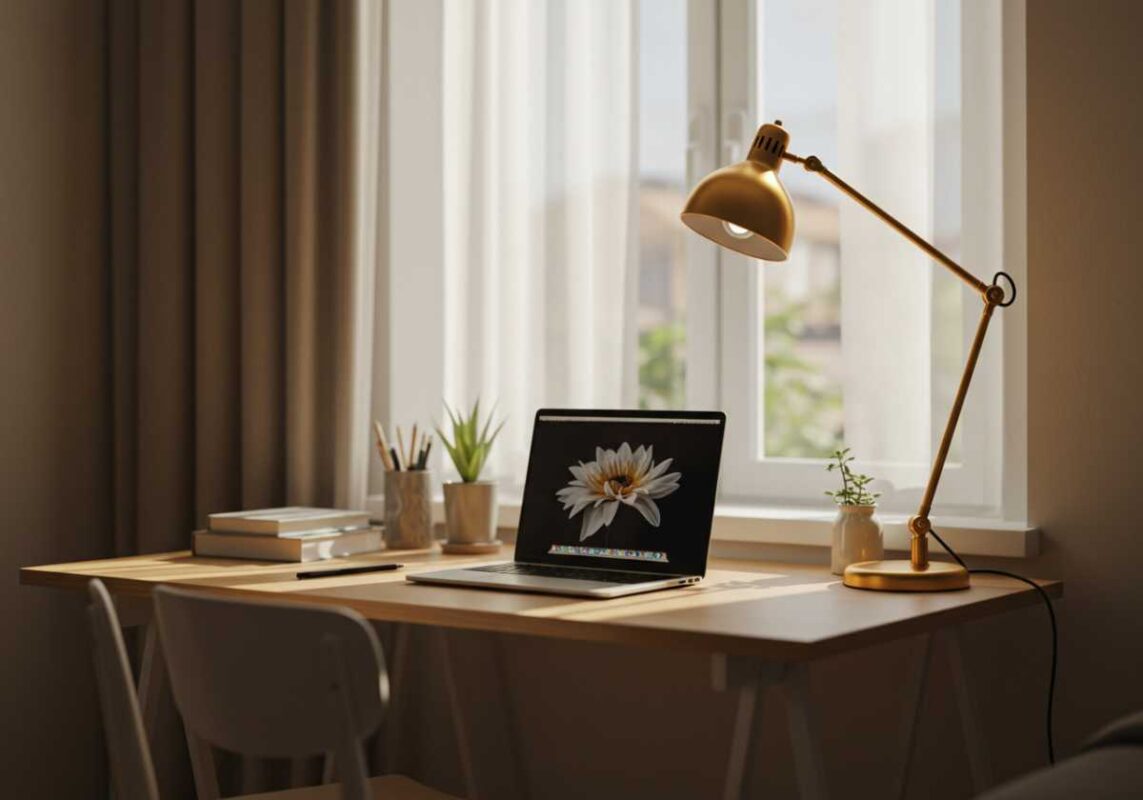
Task Lighting for the Win
When natural light isn’t cutting it (hello, winter afternoons), combine overhead lighting with task lighting. I’m talking about a proper desk lamp here, not the sad ceiling fixture that makes everything look like a horror movie.
The IKEA Fors work lamp is an affordable champion that gets the job done without breaking the bank.
Organization: Taming the Chaos
Vertical Storage Is Your Secret Weapon
Small space? Think vertical! Wall-mounted shelves, pegboards, and floating storage can hold all your stuff without eating up precious desk real estate.
I installed simple floating shelves above my desk for books, plants, and those random office supplies that seem to multiply overnight. It keeps everything visible but off my work surface – pure genius, if I do say so myself.
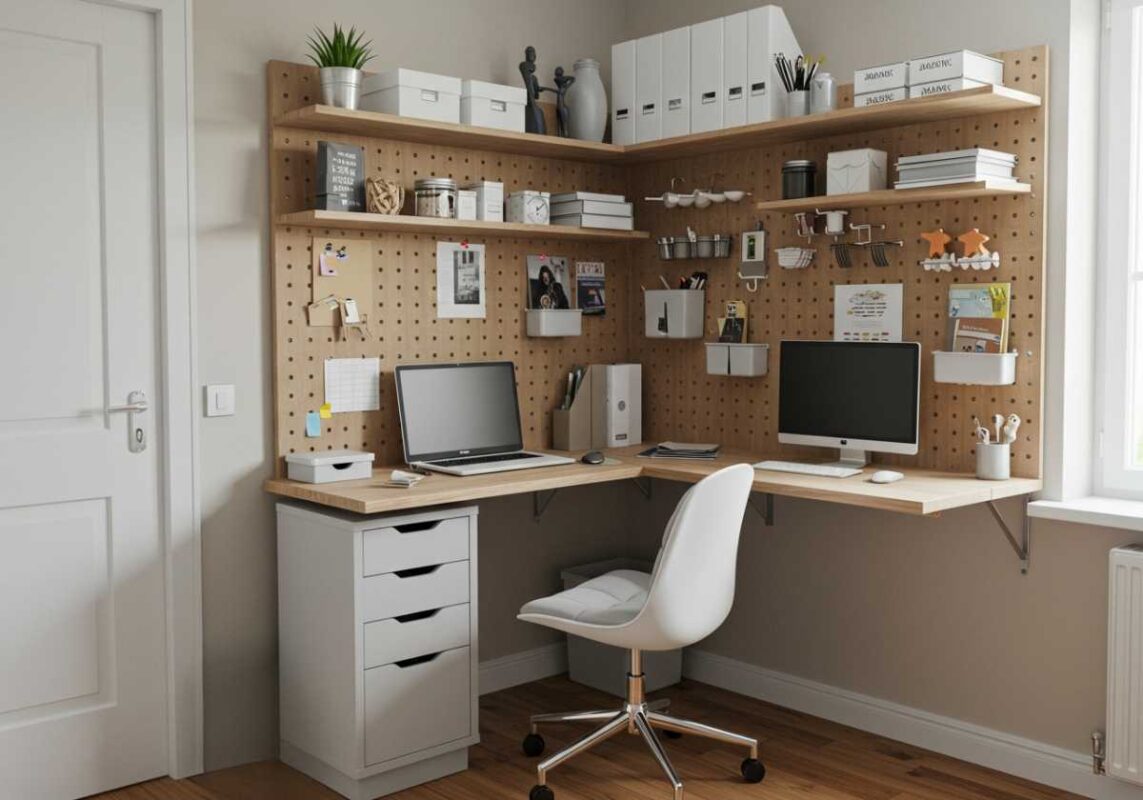
The “Everything in Its Place” Philosophy
Here’s what I wish someone had told me earlier: if you can’t see it, you’ll forget about it. Use clear containers, labeled bins, and drawer organizers to keep everything visible and accessible.
My desk has designated spots for:
- Daily essentials (pens, sticky notes, lip balm – the important stuff)
- Tech accessories (chargers, cables, headphones)
- Reference materials (notebooks, important papers)

Budget-Friendly Hacks That Actually Work
Shop Your House First
Before you buy anything, do a “shopping trip” around your own home. That dining table gathering dust? Could be your new desk. The decorative pillow from your couch? Instant lumbar support. That lamp from your bedroom? Perfect task lighting.
I furnished 70% of my home office with stuff I already owned – just rearranged and repurposed. It felt like getting new furniture without spending a dime!
DIY Solutions That Don’t Look DIY
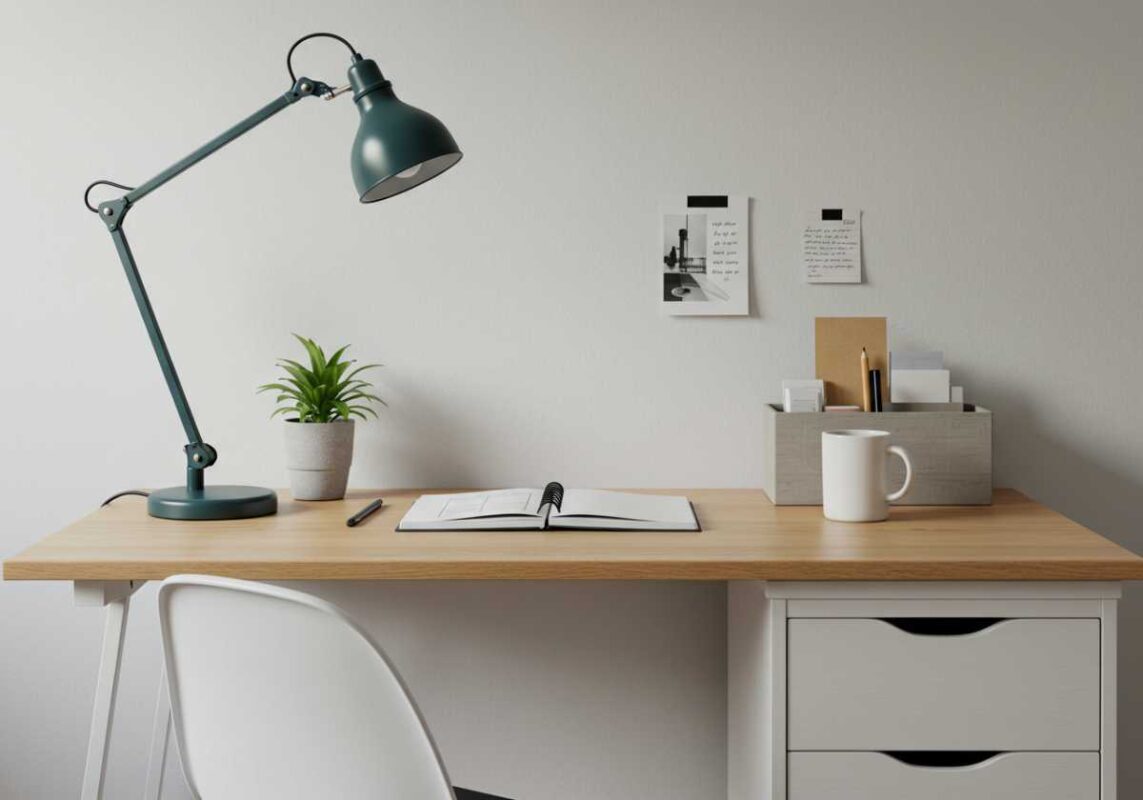
Plywood and hairpin legs = instant modern desk IKEA Alex drawers + wood top = professional storage solution Corkboard + fabric = custom inspiration board
The key is choosing materials that look intentional. Skip the obviously cheap stuff that’ll make your space look like a college dorm (unless that’s your vibe – no judgment!).
Thrift Store Treasures
Some of my favorite home office pieces came from thrift stores and Facebook Marketplace. That mid-century desk chair? $25. The vintage desk lamp? $15. You just need to be patient and know what to look for.
What to thrift:
- Desk chairs (reupholster if needed)
- Desk lamps and lighting
- Decorative storage baskets
- Artwork and decor
What to buy new:
- Anything ergonomic (keyboards, mouse pads, lumbar support)
- Technology and cables
- Task lighting with specific features
Making It Personal (Because You’re Not a Robot)
Add Some Personality
Your home office should feel like your space, not some sterile corporate environment. Add plants, photos, artwork – whatever makes you happy to be there.
I have a small succulent collection on my desk (hard to kill, very forgiving), some motivational quotes on the wall, and photos that make me smile. It sounds cheesy, but it genuinely makes work feel less… work-y.
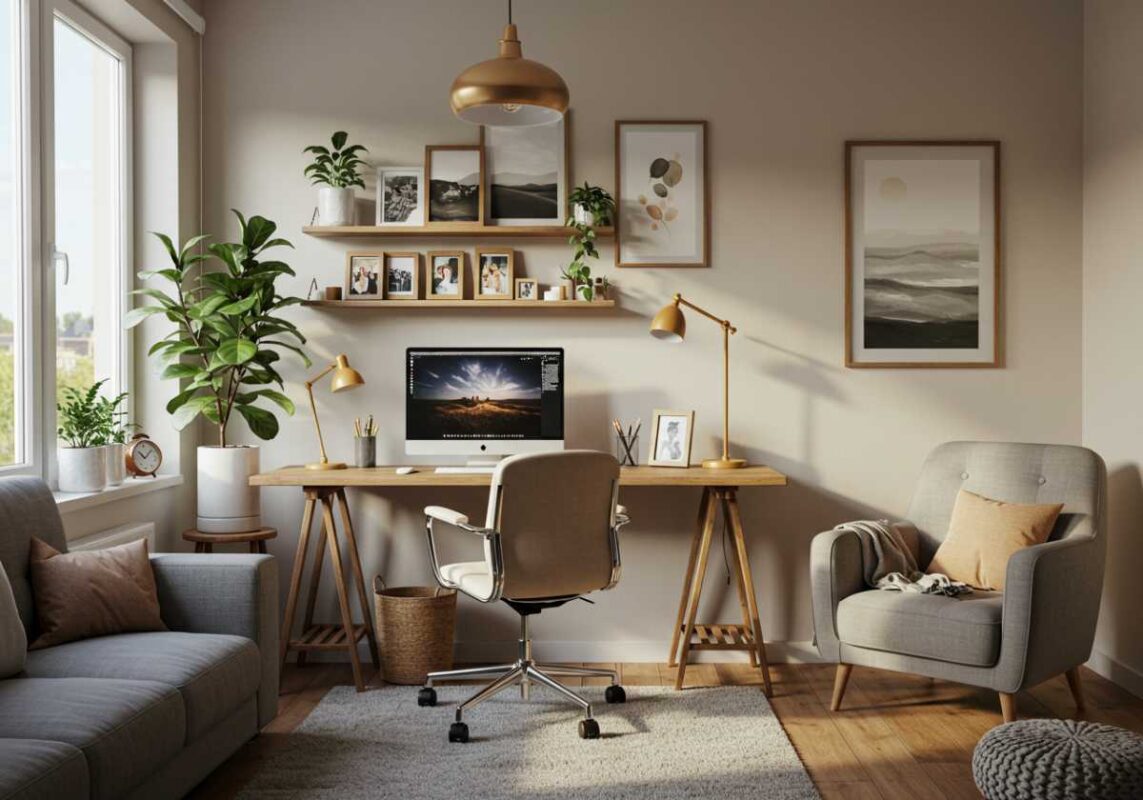
Create Zones for Different Activities
Even in a small space, try to create distinct areas:
- Focus zone (your main desk setup)
- Relaxation corner (comfortable chair for breaks)
- Storage zone (everything organized and out of sight)
This helps your brain switch between different modes and keeps you from feeling like you’re stuck in one spot all day.
The Reality Check: What You Actually Need vs. What Instagram Tells You
Let’s be honest – social media makes it seem like every home office needs to look like it belongs in a magazine. You don’t need the perfect aesthetic to be productive. You need functionality first, pretty second.
Start with these essentials:
- Comfortable, supportive seating
- Proper desk height
- Good lighting
- External keyboard and mouse
- Basic organization system
Everything else is just icing on the cake. IMO, a functional workspace that you actually use is way better than a picture-perfect setup that doesn’t work for your life.
Troubleshooting Common Problems
“I Don’t Have a Dedicated Room”
Join the club! Most of us are working with corners, nooks, or shared spaces. The key is creating boundaries – even if it’s just a different chair that signals “work mode” or a folding screen that sections off your space.
“My Space Is Tiny”
Wall-mounted desks, fold-down surfaces, and multi-functional furniture are your friends. I’ve seen incredible setups in closets, bedroom corners, and even hallway nooks. It’s not about the size; it’s about making it work for you.
“I Keep Getting Distracted”
This one’s tricky because distractions at home are real (looking at you, laundry pile). Position your desk so you’re facing away from high-traffic areas and create visual barriers if possible. Sometimes a simple room divider or even a tall plant can help create that mental separation.
Your Action Plan: Where to Start
Feeling overwhelmed? Here’s your step-by-step game plan:
- Assess your current situation – what’s working, what’s not?
- Fix the biggest pain point first (usually the chair or desk height)
- Add proper lighting (natural + task lighting)
- Organize your essentials (everything needs a home)
- Make it yours (add personality and comfort touches)
Remember, this doesn’t have to happen overnight. I built my office over several months, adding and tweaking as I figured out what actually worked for my day-to-day life.
The Bottom Line
Setting up a home office that actually works isn’t about having the fanciest gear or the biggest budget – it’s about creating a space that supports how you work best. Whether that’s a minimalist setup that helps you focus or a cozy corner packed with inspiration, the “perfect” home office is the one that makes you want to sit down and get stuff done.
Trust me, once you’ve experienced the joy of working in a space that doesn’t make you want to throw your laptop out the window, you’ll wonder why you waited so long to make it happen. Your back, your productivity, and your sanity will thank you!
Now stop reading about it and go transform that chaotic corner into the productivity powerhouse you deserve. You’ve got this! ✨
